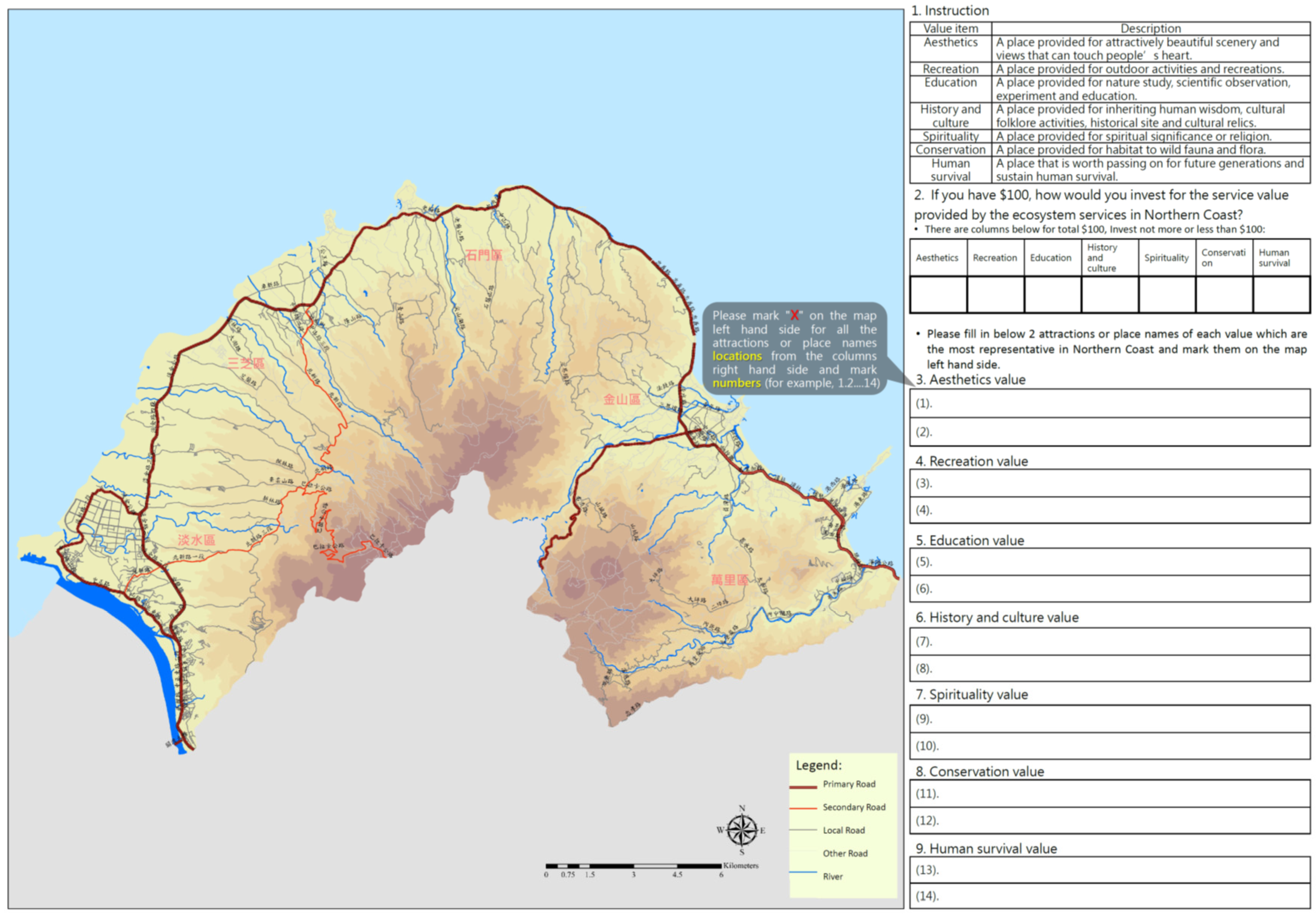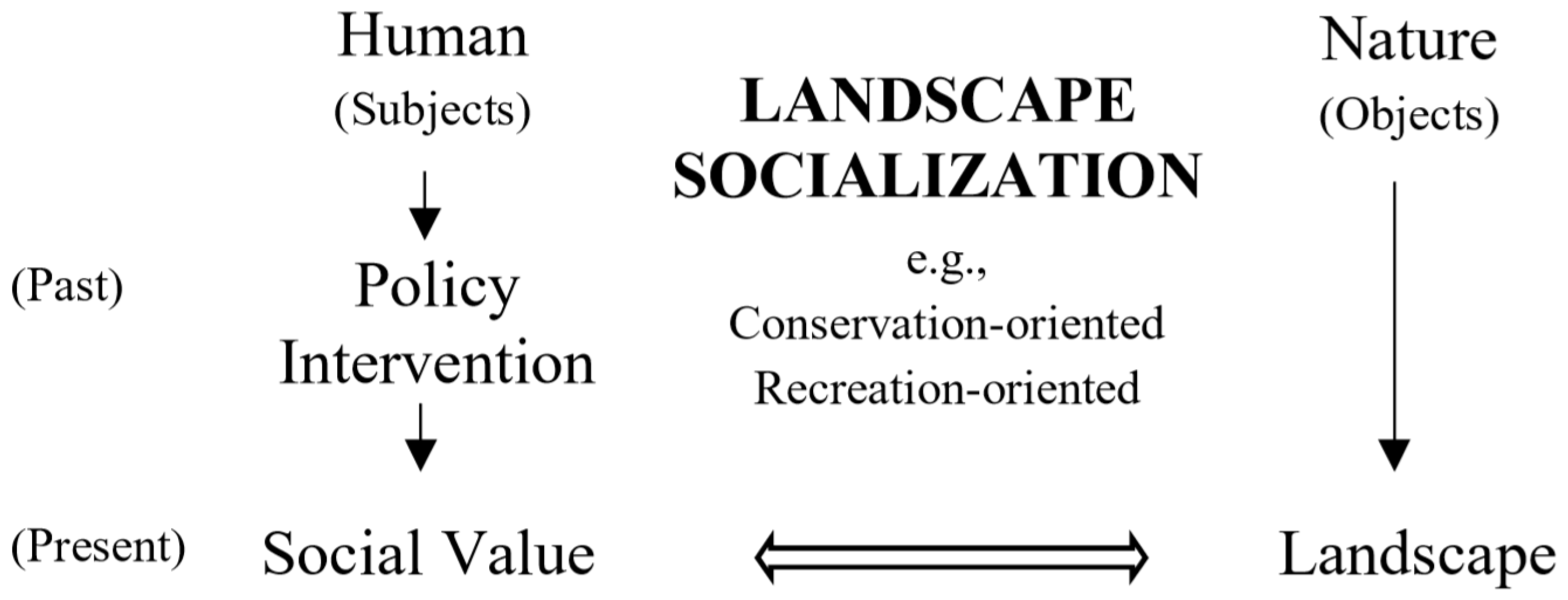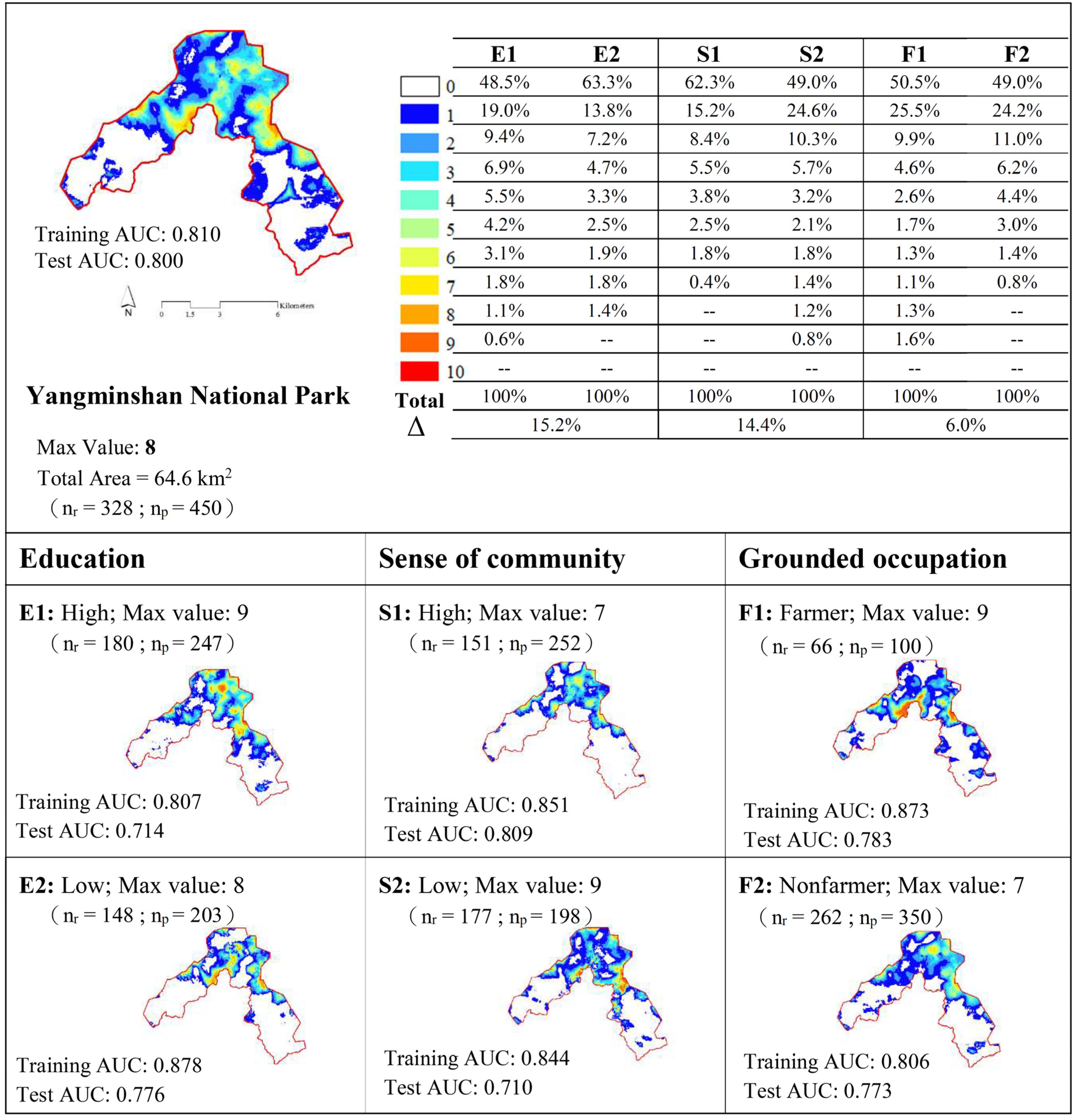Understanding Human–Nature Connections Through Landscape Socialization
Abstract
1. Introduction
2. Methodology
2.1. Conceptual Framework
2.2. Study Area
2.3. Measures
2.3.1. Background Measurement
2.3.2. Social Values Measurement
2.3.3. Index of Dissimilarity
2.4. Survey Implementation
3. Results
4. Discussion
4.1. Internalization of Connections to Nature
4.2. Landscape Socialization: Incorporating Daily Life in Policy Interventions
5. Conclusions
Funding
Acknowledgments
Conflicts of Interest
Appendix A

References
- Pritchard, A.; Richardson, M.; Sheffield, D.; McEwan, K. The Relationship between Nature Connectedness and Eudaimonic Well-Being: A Meta-analysis. J. Happiness Stud. 2020, 21, 1145–1167. [Google Scholar] [CrossRef]
- Hurly, J.; Walker, G.J. Nature in our lives: Examining the human need for nature relatedness as a basic psychological need. J. Leis. Res. 2019, 50, 290–310. [Google Scholar] [CrossRef]
- Maller, C.; Townsend, M.; Pryor, A.; Brown, P.; Leger, L.S. Healthy nature healthy people: ‘contact with nature’ as an upstream health promotion intervention for populations. Health Promot. Int. 2006, 21, 45–54. [Google Scholar] [CrossRef] [PubMed]
- Phills, J.A.; Deiglmeier, K.; Miller, D.T. Rediscovering social innovation. Stanf. Soc. Innov. Rev. 2008, 6, 34–43. [Google Scholar]
- Sherrouse, B.C.; Semmens, D.J. Social values for ecosystem services, version 3.0 (SolVES 3.0)—Documentation and user manual. US Geol. Surv. Open-File Rep. 2015, 1008, 65. [Google Scholar] [CrossRef]
- Ives, C.D.; Abson, D.J.; von Wehrden, H.; Dorninger, C.; Klaniecki, K.; Fischer, J. Reconnecting with nature for sustainability. Sustain. Sci. 2018, 13, 1389–1397. [Google Scholar] [CrossRef]
- Muhar, A.; Raymond, C.M.; Van den Born, R.J.G.; Bauer, N.; Böck, K.; Braito, M.; Buijs, A.; Flint, C.; de Groot, W.T.; Ives, C.D.; et al. A model integrating social-cultural concepts of nature into frameworks of interaction between social and natural systems. J. Environ. Plan. Manag. 2018, 61, 756–777. [Google Scholar] [CrossRef]
- Millennium Ecosystem Assessment. Ecosystems and Human Well-Being: Synthesis; Island Press: Washington, DC, USA, 2005. [Google Scholar]
- Ives, C.D.; Giusti, M.; Fischer, J.; Abson, D.J.; Klaniecki, K.; Dorninger, C.; Laudan, J.; Barthel, S.; Abernethy, P.; Martín-López, B.; et al. Human-nature connection: A multidisciplinary review. Curr. Opin. Environ. Sustain. 2017, 26–27, 106–113. [Google Scholar] [CrossRef]
- Brown, G. Mapping Spatial Attributes in Survey Research for Natural Resource Management: Methods and Applications. Soc. Nat. Resour. 2004, 18, 17–39. [Google Scholar] [CrossRef]
- Hobbs, R. Future landscapes and the future of landscape ecology. Landsc. Urban Plan. 1997, 37, 1–9. [Google Scholar] [CrossRef]
- Wood, S.L.R.; Jones, S.K.; Johnson, J.A.; Brauman, K.A.; Chaplin-Kramer, R.; Fremier, A.; Girvetz, E.; Gordon, L.J.; Kappel, C.V.; Mandle, L.; et al. Distilling the role of ecosystem services in the Sustainable Development Goals. Ecosyst. Serv. 2018, 29, 70–82. [Google Scholar] [CrossRef]
- Unite Nations. New, More Effective Forms of Collaboration among Diverse Actors Essential to Help Vulnerable Groups, Speakers Tell Economic and Social Council Partnership Forum (Meetings Coverage & Press Releases 11 April 2019). Available online: https://www.un.org/press/en/2019/ecosoc6970.doc.htm (accessed on 9 August 2020).
- Langley, M.C. Storied landscapes make us (modern) human: Landscape socialisation in the Palaeolithic and consequences for the archaeological record. J. Anthropol. Archaeol. 2013, 32, 614–629. [Google Scholar] [CrossRef]
- Kühne, O. Grundzüge einer konstruktivistischen Landschaftstheorie und ihre Konsequenzen für die räumliche Planung. Raumforsch. Raumordn. 2009, 67, 395–404. [Google Scholar] [CrossRef]
- Kühne, O. The streets of Los Angeles: Power and the infrastructure landscape. Landsc. Res. 2015, 40, 139–153. [Google Scholar] [CrossRef]
- Kühne, O. The differentiated socialization of landscape. In Landscape Theories; Springer: Wiesbaden, Germany, 2019; pp. 59–72. [Google Scholar]
- Thwaites, K. Experiential Landscape Place: An exploration of space and experience in neighbourhood landscape architecture. Landsc. Res. 2001, 26, 245–255. [Google Scholar] [CrossRef]
- Liu, X.; Wang, J.Y.; Wang, Q.F. Current status and conservation strategies for Isoetes in China: A case study for the conservation of threatened aquatic plants. Oryx 2005, 39, 335–338. [Google Scholar] [CrossRef]
- Lin, J.J.; Liao, R.Y. Sustainability SI: Bikeway network design model for recreational bicycling in scenic areas. Netw. Spat. Econ. 2016, 16, 9–31. [Google Scholar] [CrossRef]
- Chavis, D.M.; Lee, K.S.; Acosta, J.D. The Sense of Community (SCI) Revised: The Reliability and Validity of the SCI-2. In Proceedings of the Paper Presented at the 2nd International Community Psychology Conference, Lisboa, Portugal, 4–6 June 2008. [Google Scholar]
- Petway, J.R.; Lin, Y.-P.; Wunderlich, R. Analyzing opinions on sustainable agriculture: Toward increasing farmer knowledge of organic practices in Taiwan-Yuanli Township. Sustainability 2019, 11, 3843. [Google Scholar] [CrossRef]
- Riper, C.V.; Kyle, G.T.; Sutton, S.G.; Barnes, M.; Sherrouse, B.C. Mapping outdoor recreationists’ perceived social values for ecosystem services at Hinchinbrook Island National Park, Australia. Appl. Geogr. 2012, 35, 164–173. [Google Scholar] [CrossRef]
- Sherrouse, B.C.; Semmens, D.J.; Clement, J.M. An application of Social Values for Ecosystem Services (SolVES) to three national forests in Colorado and Wyoming. Ecol. Indic. 2014, 36, 68–79. [Google Scholar] [CrossRef]
- Sherrouse, B.C.; Semmens, D.J.; Ancona, Z.H.; Brunner, N.M. Analyzing land-use change scenarios for trade-offs among cultural ecosystem services in the Southern Rocky Mountains. Ecosyst. Serv. 2017, 26, 431–444. [Google Scholar] [CrossRef]
- Sherrouse, B.C.; Clement, J.M.; Semmens, D.J. A GIS application for assessing, mapping, and quantifying the social values of ecosystem services. Appl. Geogr. 2011, 31, 748–760. [Google Scholar] [CrossRef]
- Duncan, O.D.; Duncan, B. A methodological analysis of segregation indexes. Am. Sociol. Rev. 1955, 20, 210–217. [Google Scholar] [CrossRef]
- Peng, L.-P.; Wang, C.-J.; Onitsuka, K. Collaborative Conservation of a Socio-Ecological Production Landscape through ICT Tools. Environments 2017, 4, 63. [Google Scholar] [CrossRef]
- Biernacki, P.; Waldorf, D. Snowball sampling: Problems and techniques of chain referral sampling. Sociol. Methods Res. 1981, 10, 141–163. [Google Scholar] [CrossRef]
- Piller, I. Identity constructions in multilingual advertising. Lang. Soc. 2001, 30, 153–186. [Google Scholar] [CrossRef]
- Yabiku, S.T.; Casagrande, D.G.; Farley-Metzger, E. Preferences for landscape choice in a southwestern desert city. Environ. Behav. 2008, 40, 382–400. [Google Scholar] [CrossRef]
- Leibenath, M.; Otto, A. Local debates about ‘landscape’ as viewed by German regional planners: Results of a representative survey in a discourse-analytical framework. Land Use Policy 2013, 32, 366–374. [Google Scholar] [CrossRef]
- Urry, J. Mobilities; Polity: London, UK, 2007. [Google Scholar]
- Peng, L.P.; Hsieh, Y.S. Settlement Typology and Community Participation in Participatory Landscape Ecology of Residents. Landsc. Res. 2015, 40, 593–609. [Google Scholar] [CrossRef]
- Nisbet, E.K.; Zelenski, J.M.; Murphy, S.A. The Nature Relatedness Scale: Linking Individuals’ Connection With Nature to Environmental Concern and Behavior. Environ. Behav. 2009, 41, 715–740. [Google Scholar] [CrossRef]
- Riechers, M.; Balázsi, Á.; Abson, D.; Fischer, J. The influence of landscape change on multiple dimensions of human–nature connectedness. Ecol. Soc. 2020, 25, 3. [Google Scholar] [CrossRef]
- Fried, M. Continuities and Discontinuities of Place. J. Environ. Psychol. 2000, 20, 193–205. [Google Scholar] [CrossRef]
- Baker, D.A.; Palmer, R.J. Examining the effects of perceptions of community and recreation participation on quality of life. Soc. Indic. Res. 2006, 75, 395–418. [Google Scholar] [CrossRef]
- Stewart, W.P.; Liebert, D.; Larkin, K.W. Community identities as visions for landscape change. Landsc. Urban Plan. 2004, 69, 315–334. [Google Scholar] [CrossRef]
- Kals, E.; Schumacher, D.; Montada, L. Emotional affinity toward nature as a motivational basis to protect nature. Environ. Behav. 1999, 31, 178–202. [Google Scholar] [CrossRef]
- Stedman, R.C. Is it really just a social construction? The contribution of the physical environment to sense of place. Soc. Nat. Resour. 2003, 16, 671–685. [Google Scholar] [CrossRef]
- Görg, C. Landscape governance: The “politics of scale” and the “natural” conditions of places. Geoforum 2007, 38, 954–966. [Google Scholar] [CrossRef]
- Chan, K.M.; Balvanera, P.; Benessaiah, K.; Chapman, M.; Díaz, S.; Gómez-Baggethun, E.; Gould, R.; Hannahs, N.; Jax, K.; Klain, S.; et al. Opinion: Why protect nature? Rethinking values and the environment. Proc. Natl. Acad. Sci. USA 2016, 113, 1462–1465. [Google Scholar] [CrossRef]
- Klain, S.C.; Olmsted, P.; Chan, K.M.A.; Satterfield, T. Relational values resonate broadly and differently than intrinsic or instrumental values, or the New Ecological Paradigm. PLoS ONE 2017, 12, e0183962. [Google Scholar] [CrossRef]
- Díaz, S.; Pascual, U.; Stenseke, M.; Martín-López, B.; Watson, R.T.; Molnár, Z.; Hill, R.; Chan, K.M.A.; Baste, I.A.; Brauman, K.A.; et al. Assessing nature’s contributions to people. Science 2018, 359, 270–272. [Google Scholar] [CrossRef]
- Daniel, T.C.; Muhar, A.; Arnberger, A.; Aznar, O.; Boyd, J.W.; Chan, K.M.; Costanza, R.; Elmqvist, T.; Flint, C.G.; Gobster, P.H.; et al. Contributions of cultural services to the ecosystem services agenda. Proc. Natl. Acad. Sci. USA 2012, 109, 8812–8819. [Google Scholar] [CrossRef] [PubMed]
- Stotten, R. Farmers’ perspectives on cultural landscapes in central Switzerland: How landscape socialization and habitus influence an aesthetic appreciation of landscape. Soc. Nat. Resour. 2016, 29, 166–184. [Google Scholar] [CrossRef]
- Stotten, R. Kulturlandschaft gemeinsam verstehen—Praktische Beispiele der Landschaftssozialisation aus dem Schweizer Alpenraum. Geogr. Helv. 2013, 68, 117–127. [Google Scholar] [CrossRef]




| No. | Measure Items |
|---|---|
| 1 | I am vital to this community because I am a part of it. |
| 2 | Community members and I value the same things. |
| 3 | This community can truly meet the needs of its members. |
| 4 | I am very happy to be a member of this community. |
| 5 | When I have a problem, I can talk about it with members of this community. |
| 6 | Members of this community have similar needs and goals. |
| 7 | I can trust members of this community. |
| 8 | I know most of the members of this community. |
| 9 | Most members of this community know me. |
| 10 | This community has symbols and expressions of membership such as clothes, architecture, landmarks, and flags that people can recognize. |
| 11 | I devote a lot of time and effort to being a part of this community. |
| 12 | Being a member of this community is part of my identity. |
| 13 | Fitting into this community is important to me. |
| 14 | This community can influence other communities. |
| 15 | I care about what other community members think of me. |
| 16 | I have influence over what this community is like. |
| 17 | If there is a problem in this community, members can solve it. |
| 18 | This community has a good leader. |
| 19 | Being a member of this community is very important to me. |
| 20 | I engage with other community members a lot and enjoy being with them. |
| 21 | I expect to be a part of this community for a long time. |
| 22 | Members of this community share important events together, such as holidays, celebrations, and disasters. |
| 23 | I feel hopeful about the future of this community. |
| 24 | Members of this community care about each other. |
| Variables | Items | N | % | Min | Max | Mean (SD) | Skewness | Kurtosis |
|---|---|---|---|---|---|---|---|---|
| Age | 18–19 | 10 | 3.0 | −0.388 | −0.920 | |||
| 20–29 | 41 | 12.5 | ||||||
| 30–39 | 44 | 13.4 | ||||||
| 40–49 | 38 | 11.6 | ||||||
| 50–59 | 76 | 23.2 | ||||||
| 60–69 | 78 | 23.8 | ||||||
| 70 years or older | 41 | 12.5 | ||||||
| Grounded occupation | Nonfarmer | 262 | 79.9 | 1.497 | 0.244 | |||
| Farmer | 66 | 20.1 | ||||||
| Education | Uneducated | 30 | 9.1 | −0.291 | −1.192 | |||
| Elementary school | 71 | 21.6 | ||||||
| Junior high school | 47 | 14.3 | ||||||
| Senior or vocational high school | 72 | 22.0 | ||||||
| Junior college or university | 102 | 31.1 | ||||||
| Graduate school or above | 6 | 1.8 | ||||||
| Sense of community | 328 | 100.0 | 9 | 72 | 53.89 (12.62) | −0.678 | −0.020 |
Publisher’s Note: MDPI stays neutral with regard to jurisdictional claims in published maps and institutional affiliations. |
© 2020 by the author. Licensee MDPI, Basel, Switzerland. This article is an open access article distributed under the terms and conditions of the Creative Commons Attribution (CC BY) license (http://creativecommons.org/licenses/by/4.0/).
Share and Cite
Peng, L.-P. Understanding Human–Nature Connections Through Landscape Socialization. Int. J. Environ. Res. Public Health 2020, 17, 7593. https://doi.org/10.3390/ijerph17207593
Peng L-P. Understanding Human–Nature Connections Through Landscape Socialization. International Journal of Environmental Research and Public Health. 2020; 17(20):7593. https://doi.org/10.3390/ijerph17207593
Chicago/Turabian StylePeng, Li-Pei. 2020. "Understanding Human–Nature Connections Through Landscape Socialization" International Journal of Environmental Research and Public Health 17, no. 20: 7593. https://doi.org/10.3390/ijerph17207593
APA StylePeng, L.-P. (2020). Understanding Human–Nature Connections Through Landscape Socialization. International Journal of Environmental Research and Public Health, 17(20), 7593. https://doi.org/10.3390/ijerph17207593





